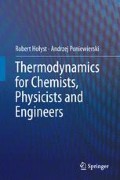Abstract
In this chapter, we show that the thermodynamic formalism can be easily extended to mixtures, in particular, the thermodynamic potentials have the same definitions as for a pure substance. We also derive the conditions of internal stability of a mixture. Then the concept of a partial molar quantity is introduced, which is a generalization of a molar quantity for a pure substance. Another useful concept is a function of mixing. It expresses the change in a given extensive state function when pure substances form a mixture at constant temperature and pressure. Next we consider a mixture of ideal gases and determine the chemical potential of a gaseous component and functions of mixing. In particular, it follows from the form of the Gibbs free energy of mixing that mixing of gases is a spontaneous process. Then we introduce the model of ideal mixture which applies to mixtures of similar substances in the liquid and solid phases. In the case of real mixtures the concepts of fugacity, activity and excess functions are used. Finally, we derive the phase rule which is a general relation between the number of phases in equilibrium, number of components and number of independent intensive parameters in the system.
Access this chapter
Tax calculation will be finalised at checkout
Purchases are for personal use only
Notes
- 1.
Before 1982 the value 101 325 Pa (=1 atm) was used.
- 2.
The concept of absolute activity, λ=exp(μ/RT), is also used but in this book we always mean the relative activity a.
- 3.
The compressibility of a liquid becomes large only near the critical point.
- 4.
It should not be confused with the number of degrees of freedom of a molecule and with the fugacity, for which we have used the same symbol.
Author information
Authors and Affiliations
Rights and permissions
Copyright information
© 2012 Springer Science+Business Media Dordrecht
About this chapter
Cite this chapter
Hołyst, R., Poniewierski, A. (2012). Mixtures. In: Thermodynamics for Chemists, Physicists and Engineers. Springer, Dordrecht. https://doi.org/10.1007/978-94-007-2999-5_7
Download citation
DOI: https://doi.org/10.1007/978-94-007-2999-5_7
Publisher Name: Springer, Dordrecht
Print ISBN: 978-94-007-2998-8
Online ISBN: 978-94-007-2999-5
eBook Packages: Physics and AstronomyPhysics and Astronomy (R0)

